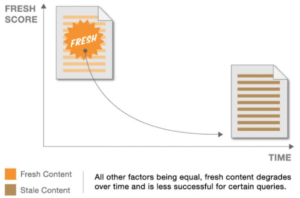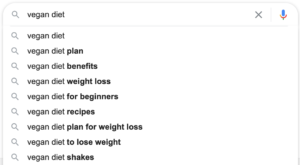How to rank higher
Do you want to increase your rankings on Google?
The best place to start is with some simple SEO dos and don’ts for beginners.
We all know that writing blogs is one way to target keywords relevant to your business and increase your rankings for them.
But writing blogs can be time-consuming. You need to find the right topic, make sure it’s optimised for SEO, then upload it and wait a few weeks for it to be indexed by Google.
Here’s how you can achieve faster results:
Updating your old content.
It takes less time and is just as effective as producing new content.
This illustration from SEO leader Moz shows that fresh content gradually loses its ‘fresh score’, which is something that’s factored into Google’s algorithm.

Frequently updating your content boosts its ‘fresh score’ and stops it from going stale over time.
The next time Google crawls over your website, it will notice that your content has been updated and will boost your rankings.
You will get a spike in traffic and click-through rate from doing a tiny amount of work.
But, for this to work, you need to have a good reason to update your content.
If you do it just for the sake of it or don’t make any significant changes, then Google won’t notice a difference.
Here are 5 ways to update your content properly.
Spelling and grammar

There’s nothing worse than reading back through an old post and seeing a silly spelling mistake.
While we all naturally try our best to avoid typos, they always seem to pop up one way or another.
Apart from trying to spare your blushes, there’s another reason why you should check back through old content and resolve any spelling and grammar mistakes.
According to Google Webmasters, there is a correlation between the spelling on a webpage and how reputable that webpage is.
This just goes to show that even the smallest mistakes can affect the overall quality of your content in Google’s eyes.
Improving the accuracy of your content
All things aside, Google’s ultimate goal is to provide the best experience for the user.
If you build your website with the user in mind, you’re likely to do well when it comes to how Google ranks you in their results pages.
The same applies to content.
Useful content is something Google values very highly.
Here’s how you can make sure your content consistently remains useful:
Update it to provide new information and updated content.
If you wrote a blog post two years ago about a new service just launched for 2018, then why don’t you update it? If you’re still offering it, great – say what has changed if anything, and if nothing has, then you can talk about that too.
This point is particularly relevant if you used data in your blog post. Has that data changed in the last two years? And how does this affect the overall message of your content?
By updating your content to make it accurate, your content will be more reliable for users who are searching for information.
This means you probably have a better chance of obtaining backlinks, which Moz describes as being especially valuable for SEO.
Removing broken links

It’s a really frustrating experience when you find a link in an article which looks good but it ends up leading to a missing page showing a 404 error.
As you probably know by now, Google doesn’t like frustrating user experiences.
If you have broken links in your old content, Google will identify these and will push you further down the search engine results pages.
Luckily, fixing your broken links is quite simple.
You can use the Broken Link Checker to identify any broken links on your website.
You can also use SEO software programmes such as SEMRush to run a full site audits and identify any broken or missing links.
Linking to newer, fresher resources

Another great way to improve your content is to add new links to better resources.
Updating to new and accurate sources is valuable because outbound links are an important factor that Google pays attention to.
In your blogs, you should be linking to other articles, blogs and related information that your users might enjoy exploring after they’ve read your content.
This process is worthwhile because it’s so easy and time-efficient to perform.
Here’s how to do it properly:
Don’t just replace one link for another.
Make sure you’re also updating the text around the link.
This will encourage you to make sure that you’re properly explaining why this new link is relevant and fits into your blog.
It might take you slightly longer, but it will clearly indicate to Google that you’ve made changes and taken care when updating your content.
Optimise for the right keywords
It might be the case that some of your older blog posts aren’t fully optimised for the keywords you want to rank for.
Or maybe you’ve done further keyword research since then and you want to take things in a slightly different direction.
While it might seem like a lot of effort, it’s actually quite simple to update this.
Read through your post to make sure you understand what it is you were writing about at the time. Then, just go through it and sprinkle your new keywords into the blog.
Make sure these flow with the rest of the text – anything too obvious will stand out and Google and the reader will know you’re stuffing keywords in.
As well as using your main keyword, be sure to use related keywords too.
Also known as LSI keywords, related keywords are other, usually longer search terms which are related to your main keyword.
You can find LSI keywords by typing your main keyword into Google search bar and looking at the suggested results that appear.

They help to build a more rounded piece of content which lets Google know the exact topic of your blog.
While you’re updating your blog, be sure to add plenty of LSI keywords in as well.
This is an excellent, low-effort way to update your blog and give it a boost in rankings. While you’re there, you can add in more text too – perhaps reading your old post has sparked a new idea you can write a paragraph on. Or you want to reflect back on something you have learnt. Google loves this.
Conclusion

Now you know how important updating content is.
You also know some proven ways of how to do it.
If you haven’t got the time to write a new blog or you can’t think of a relevant topic, you’re much better off updating an existing blog than posting something that’s not valuable.
Remember that once you’ve updated a blog, you can share it and promote it again, the same as you did the first time around.
Good luck!





